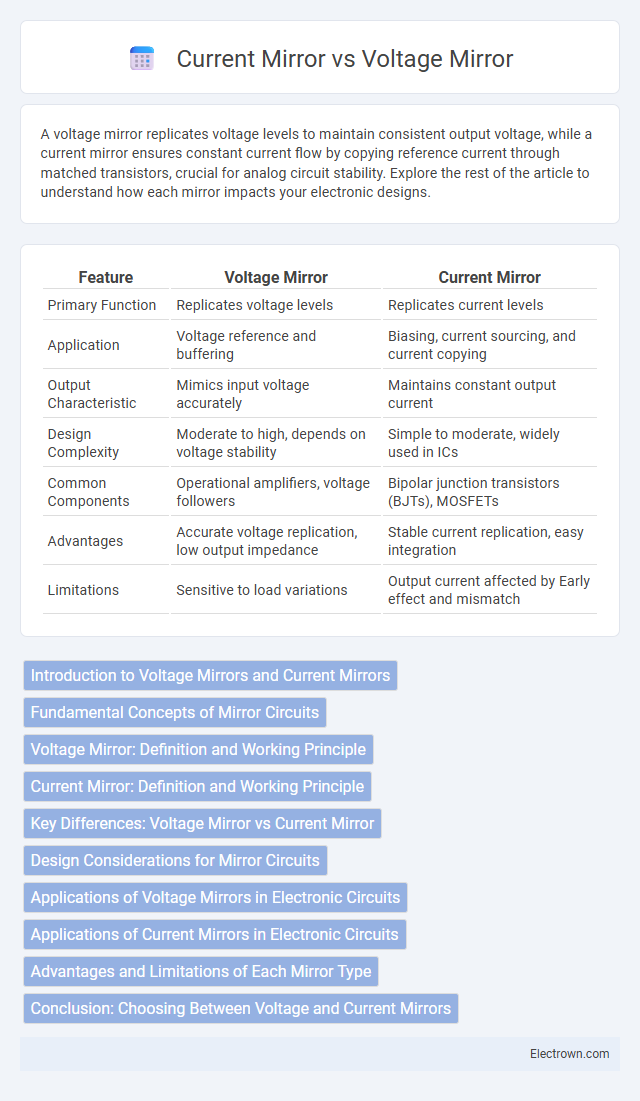A voltage mirror replicates voltage levels to maintain consistent output voltage, while a current mirror ensures constant current flow by copying reference current through matched transistors, crucial for analog circuit stability. Explore the rest of the article to understand how each mirror impacts your electronic designs.
Table of Comparison
| Feature | Voltage Mirror | Current Mirror |
|---|---|---|
| Primary Function | Replicates voltage levels | Replicates current levels |
| Application | Voltage reference and buffering | Biasing, current sourcing, and current copying |
| Output Characteristic | Mimics input voltage accurately | Maintains constant output current |
| Design Complexity | Moderate to high, depends on voltage stability | Simple to moderate, widely used in ICs |
| Common Components | Operational amplifiers, voltage followers | Bipolar junction transistors (BJTs), MOSFETs |
| Advantages | Accurate voltage replication, low output impedance | Stable current replication, easy integration |
| Limitations | Sensitive to load variations | Output current affected by Early effect and mismatch |
Introduction to Voltage Mirrors and Current Mirrors
Voltage mirrors replicate a reference voltage to provide a stable output voltage, essential in analog circuits for biasing and signal processing. Current mirrors, by contrast, duplicate a reference current to maintain consistent current flow across components, widely used in current regulation and active load applications. Understanding the differences helps you select the appropriate mirroring technique for precision in circuit design.
Fundamental Concepts of Mirror Circuits
Voltage mirror circuits replicate an input voltage precisely at their output, maintaining a constant voltage level despite load changes, which is essential for voltage regulation applications. Current mirror circuits, on the other hand, copy an input current to the output, ensuring consistent current flow across varying loads, crucial for biasing and current steering in analog design. Understanding your application's need for stable voltage or current replication will determine whether a voltage mirror or current mirror better suits your circuit requirements.
Voltage Mirror: Definition and Working Principle
A voltage mirror is an analog circuit designed to replicate an input voltage at its output, maintaining a consistent voltage reference across different circuit stages. It operates by using feedback mechanisms and transistor pairs to accurately copy the input voltage to the output without drawing significant current. This voltage replication is essential in precision analog applications where stable voltage references ensure reliable circuit performance.
Current Mirror: Definition and Working Principle
A current mirror is an electronic circuit designed to copy or replicate the current flowing through one active device into another, maintaining a constant current regardless of load changes. It operates by using a reference current established in one transistor, which is then mirrored onto another transistor to ensure current stability and predictability in analog circuits. Your designs benefit from current mirrors by achieving accurate current control essential for biasing and signal processing applications.
Key Differences: Voltage Mirror vs Current Mirror
Voltage mirrors replicate voltage levels by maintaining a constant reference voltage across a load, ideal for applications requiring stable voltage replication. Current mirrors copy current from a reference branch to an output branch, ensuring precise current control and consistent current flow in circuits. Key differences include their primary function--voltage replication versus current replication--and their implementation, where voltage mirrors focus on voltage stability and current mirrors prioritize current accuracy.
Design Considerations for Mirror Circuits
Voltage mirror circuits require precise matching of transistor threshold voltages and careful biasing to maintain accurate voltage replication across varying load conditions. Current mirror designs emphasize device matching, channel length modulation minimization, and ensuring high output impedance to provide stable and accurate current copying. Both circuits demand consideration of temperature variation effects and transistor parameters to optimize performance and reduce systematic errors in analog integrated systems.
Applications of Voltage Mirrors in Electronic Circuits
Voltage mirrors are crucial in analog integrated circuits for accurately replicating reference voltages across multiple circuit nodes, ensuring improved signal stability and consistency. These devices are commonly used in biasing networks, differential amplifiers, and operational amplifier input stages where precise voltage replication is essential for performance. Voltage mirrors enhance circuit linearity and reduce power consumption by maintaining constant voltage levels despite variations in load or supply voltage.
Applications of Current Mirrors in Electronic Circuits
Current mirrors are essential in analog integrated circuits for biasing transistors and ensuring consistent current flow, which enhances amplifier performance and stability. They are widely used in differential amplifiers, operational amplifiers, and analog-to-digital converters where precise current replication is critical. Your circuit design benefits from current mirrors by achieving accurate current control, leading to improved linearity and reduced distortion.
Advantages and Limitations of Each Mirror Type
Voltage mirrors excel in accurately replicating voltage levels with minimal power consumption, making them suitable for precision analog circuits; however, they can suffer from loading effects that degrade performance. Current mirrors provide stable current replication ideal for biasing and signal processing, offering high output impedance but are limited by variations in transistor matching and voltage compliance range. Both mirror types demand careful design considerations to optimize linearity and temperature stability within integrated circuit applications.
Conclusion: Choosing Between Voltage and Current Mirrors
Voltage mirrors excel in maintaining constant voltage levels across circuits, making them ideal for applications requiring precise voltage regulation. Current mirrors are preferred when accurate current replication is necessary, ensuring consistent current flow for analog signal processing and biasing. Your choice depends on whether stable voltage or stable current is critical to your circuit's performance.
voltage mirror vs current mirror Infographic

 electrown.com
electrown.com